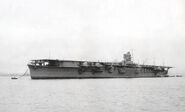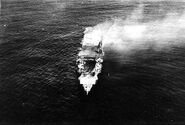Hiryū (Japanese: 飛龍, lit. Flying Dragon), a slightly enlarged version of Sōryū was laid down on 8 July 1936 at Yokosuka Naval Dockyard, launched on 16 November 1937 and commissioned on 5 July 1939.[1]
Description[]
The ship improved on her smaller sister Sōryū in a number respects, notably combat range, engines power and protection. The most notable difference in appearance was an island superstructure on the port side of the ship. Despite a number of shortcomings, Hiryu was judged by the Japanese to be a highly useful design that was to be reincarnated in the late-war Unryu-class aircraft carriers.
History[]
Hiryū was active off China during the next few years. She was a member of Chuichi Nagumo's dreaded Mobile Force, and was one of the fleet carriers that launched the deadly attack on Pearl Harbor in Dec 1941, and after that were Wake, Palau Islands, Darwin, Indian Ocean raids. She participated in the Battle of Midway and launched the aircraft that disabled the American carrier Yorktown. Hiryū then came under attack by Yorktown's SBD aircraft, which fought through Hiryū's combat air patrol fighters and a flak barrage. Captain Susumu Kawaguchi, air officer aboard Hiryū, recalled that she was hit six times during the fourth and final attack on her. One of the bombs struck the forward elevator, two just aft of the forward elevator, three just forward of the after elevator. All bombs were aimed at her hinomaru painted on her flight deck, a proud symbol of the rising sun that ironically doubled as the bull's-eye to the American pilots.
When he determined that Hiryū was unsaveable, her captain Tamon Yamaguchi gathered the 800 men who were still aboard the ship, including the wounded, on the flight deck near the bridge, and led them in yelling banzai three times toward Tokyo, followed by the playing of the national anthem. After the ceremony, the order to abandon ship was issued.
After the survivors were evacuated (without Yamaguchi, who remained on board to go down with the ship), destroyer Makigumo fired two torpedoes to scuttle her some time between 0905 and 0915 in the morning of 5 Jun 1942. The first torpedo passed under her, but the second hit her squarely in the hull.
Ensign Mandai, who floated in the water nearby when Hiryū sank, saw the giant propellers rose above the waves as the bow of the ship dipped into the ocean. He swam vigorously to escape the suction created when a ship sank; when he dared to look again, Hiryū was gone.[2] She sank at position 31°27' N 178°23' W.









